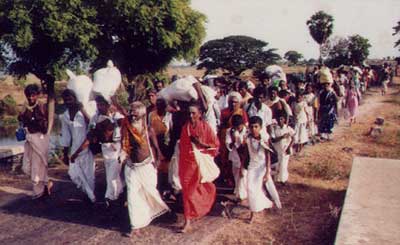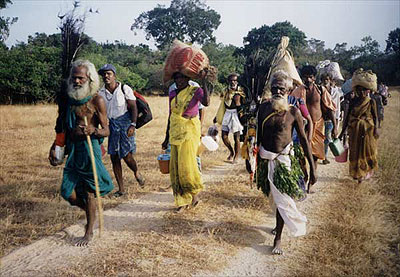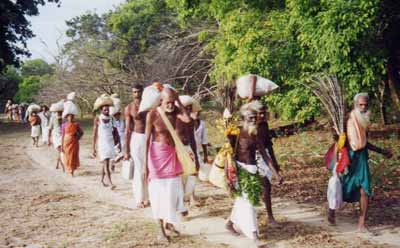|
| ||||||||

The Kataragama Pada Yatra Pilgrimageby Manik SandrasagraInvisible currents flow like mighty rivers along the paths of every pilgrimage, and borne along by these currents the traditional foot pilgrims move in their thousands from one spiritual center to another. So it has always been from as far back as the mind of man can reach. It would not be too much to say that pilgrimage plays a vital role in expressing and developing our fundamental humanity. From its central position in human affairs, pilgrimage can be seen to be the circulatory system of a greater consciousness with which humanity seeks to align itself. Of all the pilgrimages in Sri Lanka and India, the Pada Yatra from Nagadipa to Kataragama in the months of June and July is considered to be on a par with making a pilgrimage to Mount Kailasa in remote Tibet, considered by both Buddhists and Hindus to be of the highest merit. Indeed Kataragama is called Southern Kailasa. It has existed from time immemorial as the goal of those in search of wisdom and liberation. This is especially true for Muslims who, in their pilgrimage to Kataragama, renew in their own experience the journey of Prophet Moses (SAL) who in the Holy Quran goes in search of his Teacher al-Khadir, the mysterious al-Khidr, the mysterious 'Green Man' of islamic tradition. It is the view of the Muslim community in Sri Lanka and even abroad that Kataragama or Khadir-gama ('home of al-Khadir') is the very place where Prophet Moses (SAL) made his way to; and the mosque of the Holy Mahdi (SAL) there; the traditions and teachings are all part of Allah's Higher Revelation, which has existed exclusively in Sri Lanka since the time of the Prophet Adam (SAL). Even today the same revealing Angel is to be found there, at the place where the two rivers meet (Surah 28, xviii verse 61). So it is that pilgrims from every faith and community begin gathering in Nagadipa in the Jaffna Peninsula some two weeks before the Kap Hitanawa ceremony in Kataragama. At the auspicious time they set out on foot, on a journey that will last for nearly two months. Nagadipa, Selvaccaniti, Vallipuram, Mullaitivu, Trincomalee and Batticaloa are the places from which the pilgrimage has commenced for the Buddhist, Hindu, Muslim and Christian devotees who converge on Kataragama; keeping the rising sun to their left; following the ancient tracks made by the elephant clan, who first formed the path as they circumambulated Śrī Pada (Adam's Peak). All along the route, which they cover at the rate of five or six miles per day, the pilgrims halt at the traditional places of worship, where they receive dana (hospitality) from waiting villagers. In all some 73 temples are visited and at each hospitality and alms are offered to the pilgrims. The route carries them down the east coast as far as Pottuvil, where it then turns inland to cross the 60 miles of jungle that separates it from Kataragama. The pilgrims themselves are representative of the complete spectrum of society, and there are no lords or masters on the pilgrimage. Poets, singers, musicians, dancers and ecstatics are spread like a leaven through the concourse, as it moves in groups, often separated from each other, and appearing to walk alone; along the glorious, and often awe-inspiring landscapes of Sri Lanka. At night there is the glow of campfires, much shared food, continuous chants of praise from the various pilgrim groups, and of course the wisdom teachings of our traditions are rehearsed by the elders. All these factors combine to bring into being an atmosphere unique and unforgettable to those who have experienced it. One has returned to one's source. One attains to timelessness—an eternal now—such as our recent ancestors seem to know so well, and which in our own day becomes increasingly difficult to find. On the day before the flag hoisting ceremony at the mosque in Kataragama which inaugurates the festival, the pilgrims arrive in the Sacred City. Here they remain for the duration of the event; still keeping together while interacting with all of those who seek their blessings. Although all are pilgrims at the festival, those who have made the pilgrimage by foot have the power to bless those who have not. Their presence is an ornament to the gathering, and they perform several important functions in the perahera. With the conclusion of the festival the yatra pilgrims return to their homes, like everyone else; but no one who has taken part in the pilgrimage in ever quite the same again. One of the founding trustees of the Kataragama Devotees Trust, Manik Sandrasagra first experienced the Kataragama Pada Yatra in the company of German Swami Gauribāla in the early 1970's. He continues to lend his support to the tradition to this day. See also these reports:
|
|


